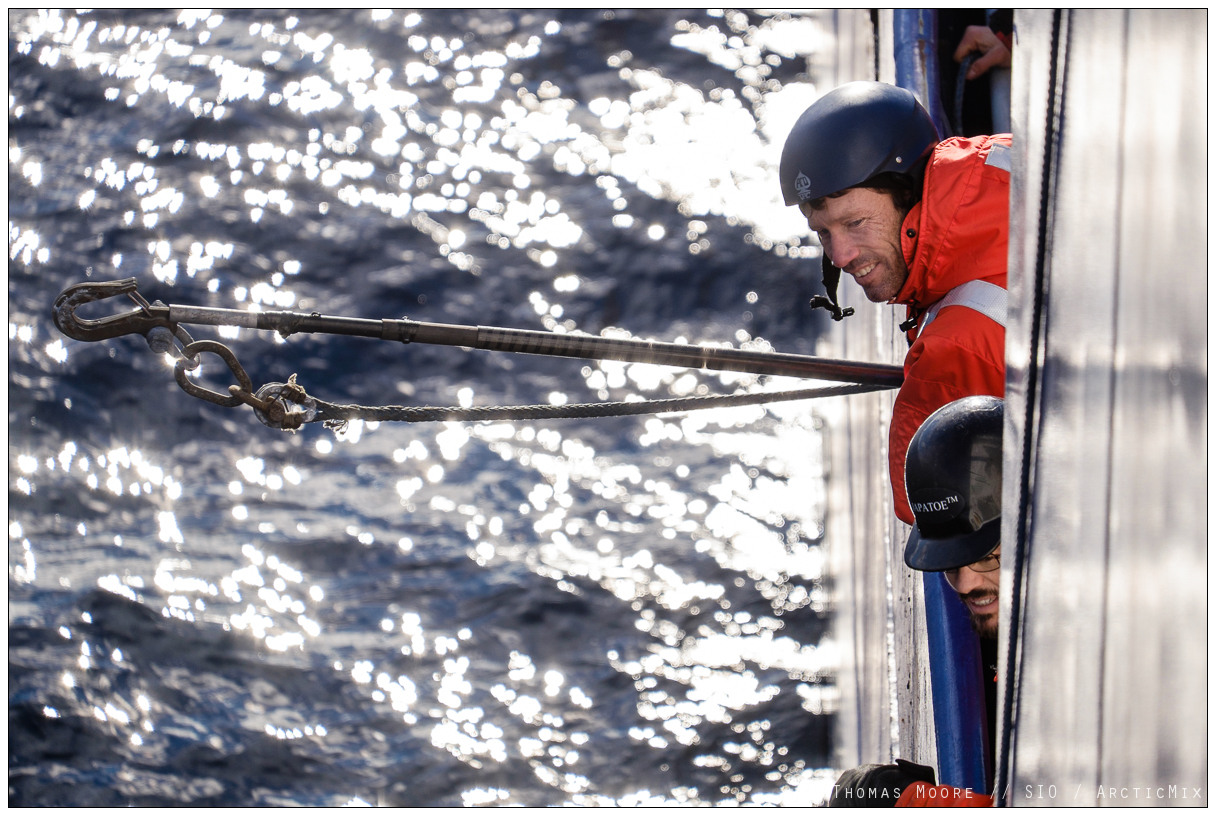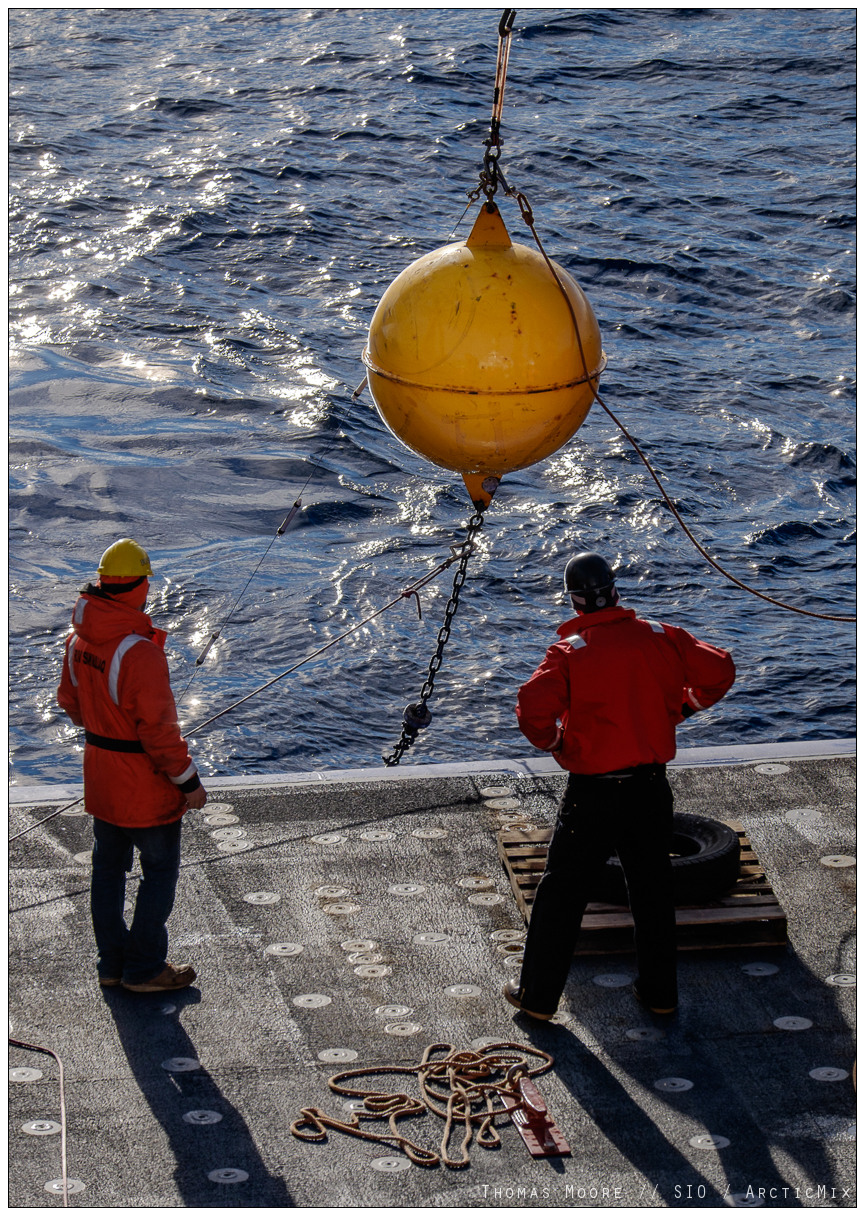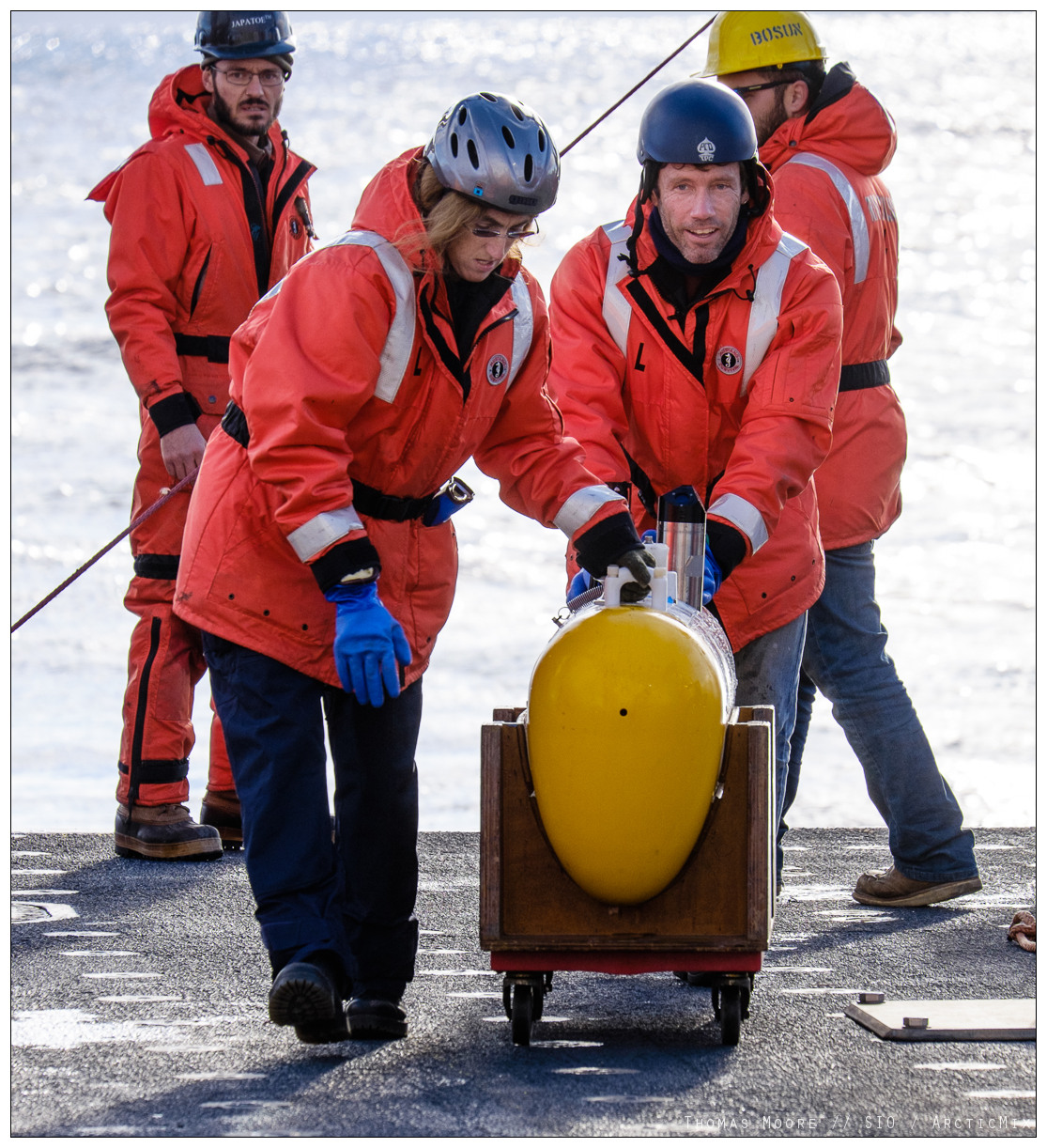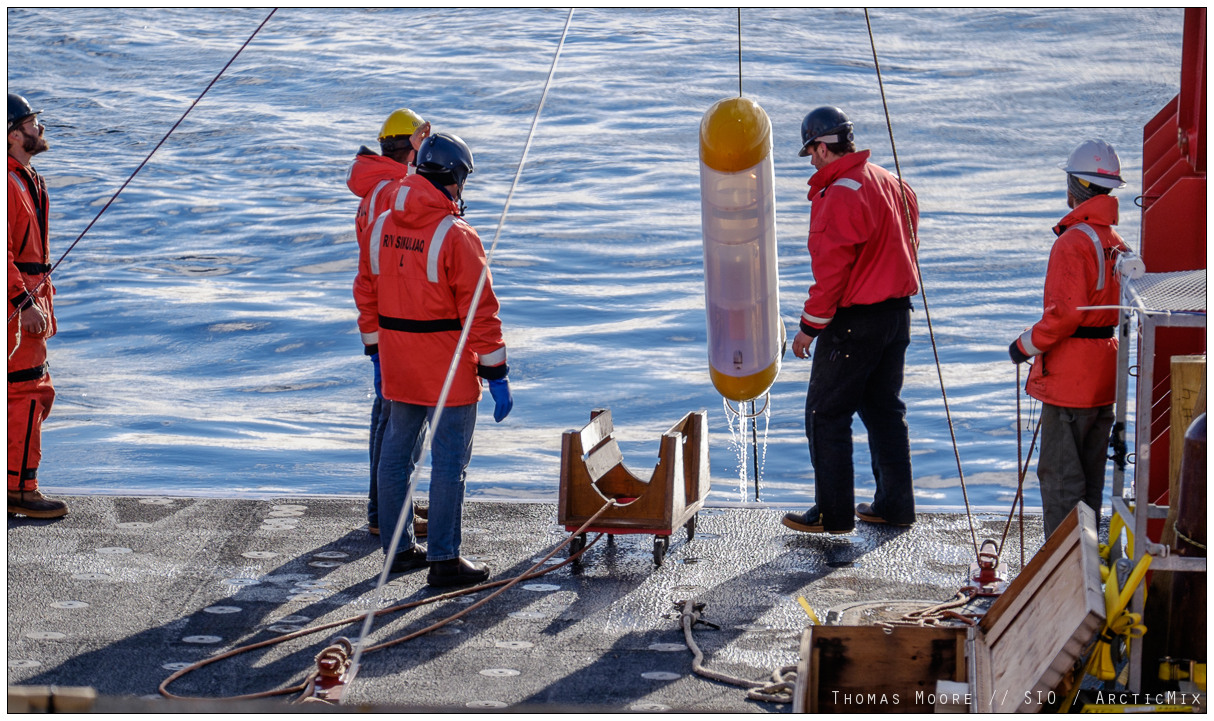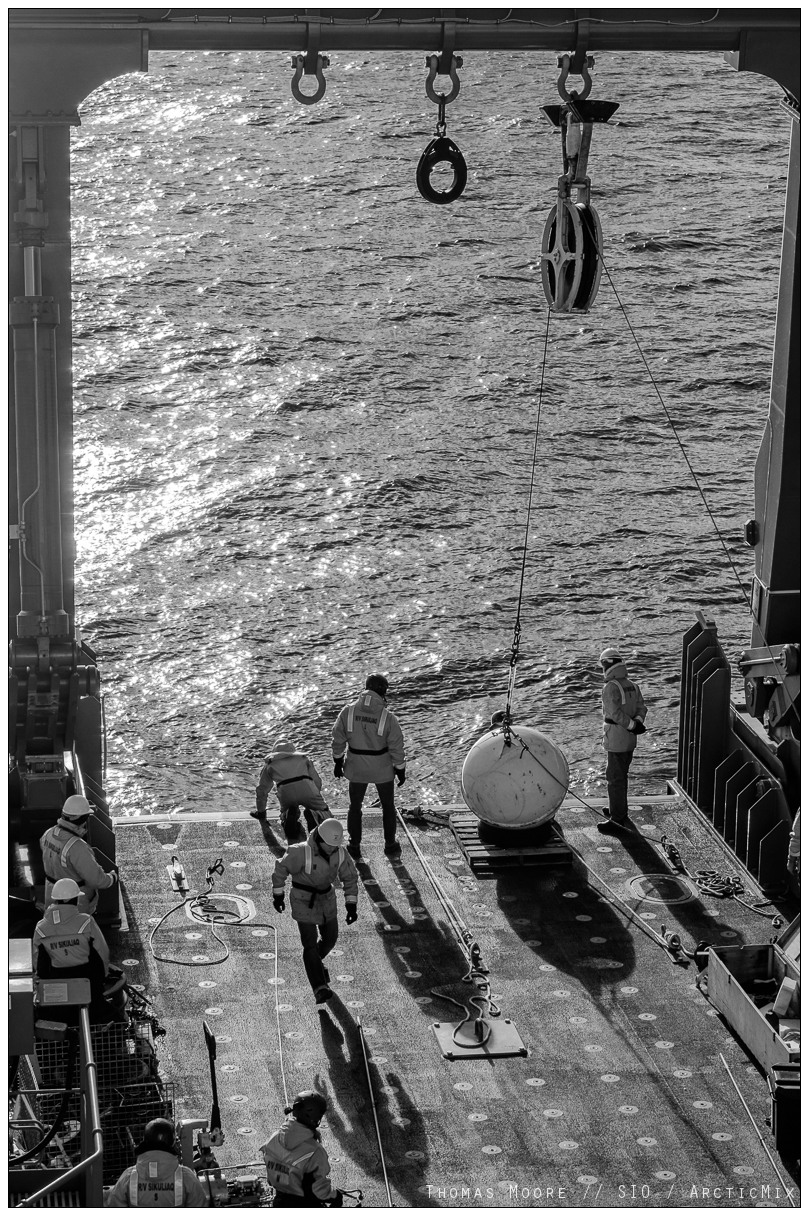Sea-going oceanographers, like those aboard the R/V Sikuliaq today, have a cautionary principle that they always keep in the back of their minds. When an expensive piece of scientific equipment, the vital infrastructure that makes up most of the budget for an ocean research team, goes over the side of a ship and into the sea you can’t expect for certain you will ever see it again. The oceanographer designs every effort, makes every plan, and works every day to get the equipment and data back, but should never take as given that what goes in the sea will all return.

Dr. Jen MacKinnon and Dr. Matthew Alford wheel a mooring robot off the back deck.
The ArcticMix mooring stands 3452 meters tall in the middle of the Beaufort Sea and when it was deployed early in September the scientists and crew of the R/V Sikuliaq literally watched as they let slip into the deep over half a million dollars worth of technology. And while there are plans and backup plans for how we will again find this undersea treasure, everyone aboard will sleep better when each meter of wire and scientific baubles are again tied to the deck. Still there is no better way to measure the ocean across its entire depth over a long period of time than employing ocean moorings. These hard-won scientific data from the real ocean are essential to formulating and tuning the global climate computer simulations that inform decision-makers and regularly make the headlines.
The primary study zone for the ArcticMix voyage is right on top of what the National Snow and Ice Data Center (NSIDC) has called ‘a striking feature of the late 2015 melt season’, a period that has ended as the fourth lowest Arctic sea-ice minimum on record. Over 19 days, as the R/V Sikuliaq made additional ocean observations nearby, the ArticMix mooring stood steady listening and learning about its patch of the Beaufort Sea.
The Arctic is a strange place oceanographically, an up-side down version of the normal ocean in that the surface water is cold and fresh while lurking below is a reservoir of warmer, saltier water, heavier than the surface layer due to its high salt content. One hypothesis in a rapidly-changing Arctic is that increasing open water allows storms to mix this deeper ocean heat upward through the generation of undersea beams of energy called ‘internal waves’, in turn melting more ice. The peculiar nature of the Arctic is what makes a hypothesis of a positive climate change feedback based on vertical mixing possible.
In the first weeks of of our voyage the ArcticMix oceanographers witnessed remarkable levels of subsurface mixing. Their sensitive instruments, leashed to the back of the R/V Sikuliaq by high-tech cables wrapped around specialized winches, saw billows of turbulence that looked just like a wave breaking on the beach, but much larger. These underwater waves could easily reach into these regions of warmer water below the ice, possibly moving some of this heat upward when they break.
While the ArcticMix scientists darted across the Beaufort looking for signs of ocean mixing over wider swaths, the undersea mooring witnessed conditions minute by minute at a single location that serves as a scientific reference for the entire voyage. The time comes to return to the scientific backbone of the entire experiment and find both the mooring equipment and all the invaluable data stored on many tiny memory cards, not unlike those in your nice camera except they are 3000 meters under the ocean.
The morning of the recovery breaks with fair winds and calm seas, the decks of the R/V Sikuliaq awash with sun for the first time since we had left Nome over 3 weeks earlier. Best of all there was no ice to be seen. Sea-ice, driven by the wind and currents, was completely out of our control and could easily have moved to cap the sea here, freezing our scientific assets beyond the reach of Sikuliaq. The ArcticMix team won another calculated roll of the dice, as the risk of mooring a five hundred thousand dollar scientific bet in an ice-filled Arctic looked to be paying off.
A button is pushed and a special transducer puts a coded ping of sound into the water. Somewhere, well over two miles below the stern of our ship, another device hears the command and releases its grip on the bottom. The ArcticMix mooring rises slowly to the surface, four feet or so every second, and within 45 minutes it’s at the surface. The top buoy is hooked and bit by bit and inch by inch the mooring is brought aboard in the Arctic sunshine. Instruments are quickly washed and rushed back into the science lab for data transfer. A team of graduate students and scientists swarm over the gigabytes of data filling the ships server and soon the first preliminary plots fill our computer screens. The mooring has witnessed exactly the kind of wind generated internal waves we’ve been looking for.
One of the measurements captured on the undersea mooring is the velocity of currents through a wide range of ocean depths. When these currents are displayed as a long series over time the clear signature of internal waves can be seen. These beams of energy, generated by the storm that passed over the Beaufort Sea weeks earlier, descend into the deeper layers of the ocean where they can “break”, and as we observed elsewhere in the Arctic, heat can be mixed into surface waters a bit like hot coffee in cold cream.
What we have seen so far in the Arctic has certainly not refuted the hypothesis there there could be a positive feedback in regional changes in sea-ice cover that could lead to an increased rate of melting. The marked energetic mixing we have seen here at the heart of the Arctic ice-melt zone could be a key in understanding a potential new climate feedback. But for now the hard work lies ahead of the ArcticMix scientists for they must carefully untangle the complex processes involved to to distinguish typical seasonal melting from longer term change, with the goal of providing new insights that will help improve the accuracy of climate forecasts for the Arctic region.
- Thomas Moore, for the ArcticMix team
- Mooring float coming up out of the water.
- Dr. Jen MacKinnon and Dr. Matthew Alford wheel a mooring robot off the back deck.
- The longest hooks you’ve ever seen reach out to snag the mooring float.
- An underwater profiling robot returns to the surface.
- Fair weather in the Arctic.
- Deck operations for the mooring recovery.
- Sikuliaq marine technician Ethan Roth waits for a profiling robot to surface.
- An ADCP returned from the deep.
- The mooring floats astride the R/V Sikuliaq.
- The team secures a mooring float.


